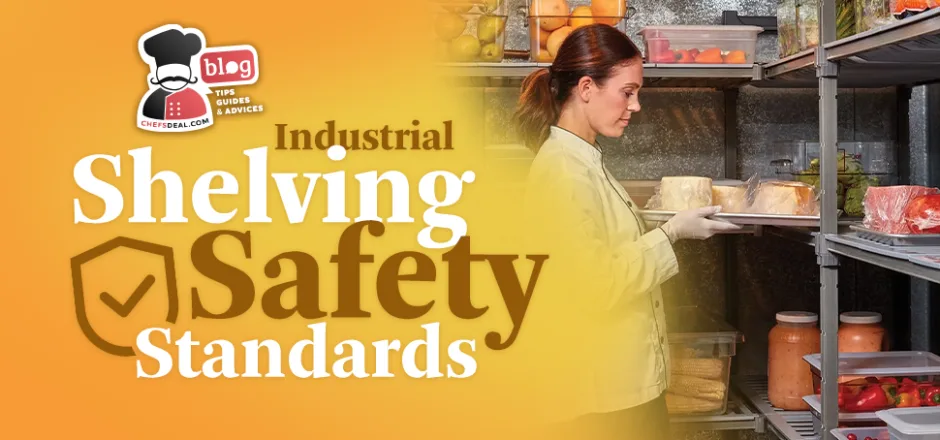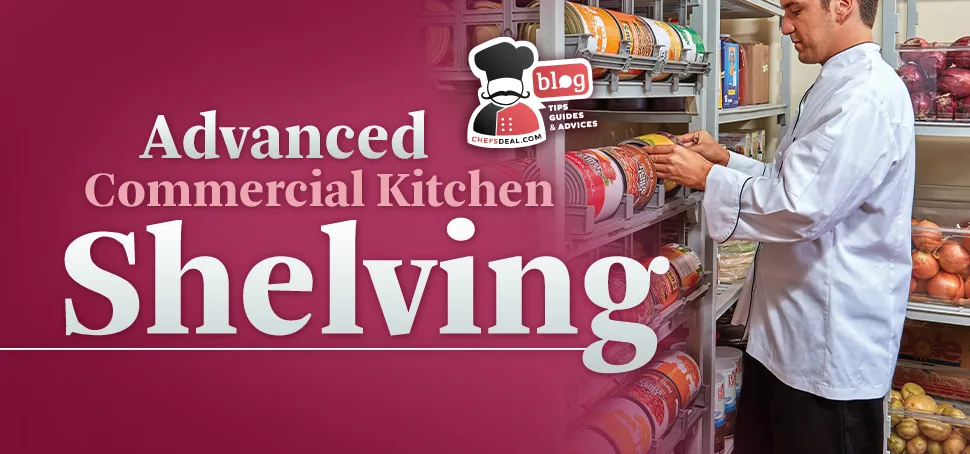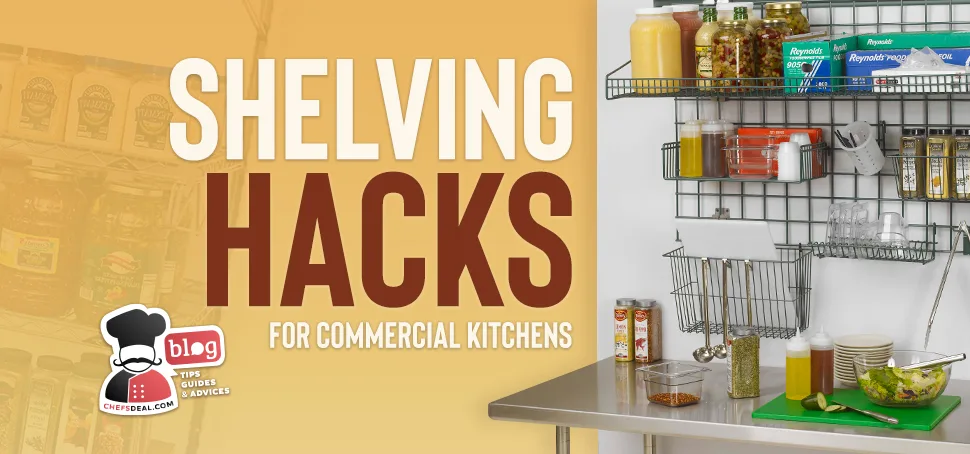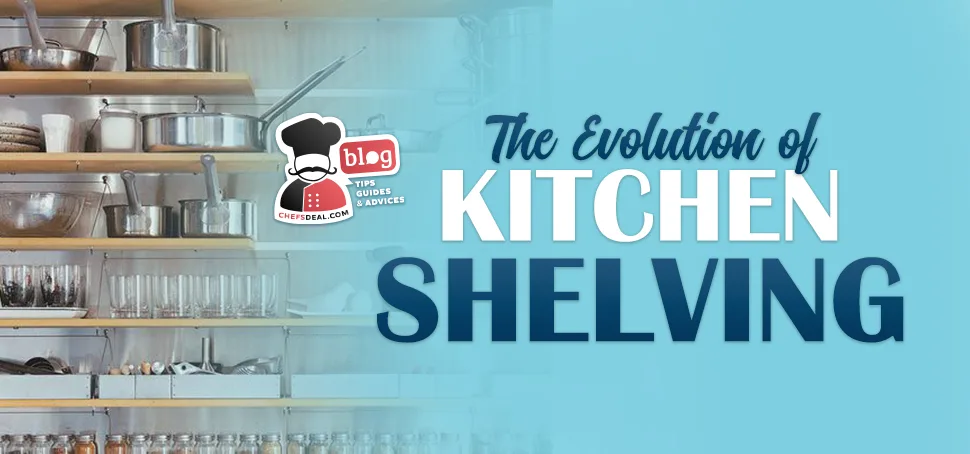Industrial kitchen shelving safety standards are the determined guidelines by governments and foundations to ensure staff, operation, and customer safety in industrial workplaces. Industrial kitchen shelving standards, such as OSHA (The Occupational Safety and Health Administration), NSF (National Sanitation Foundation), and ISO (International Organization for Standardization), cover proper construction, installation, maintenance, and usage of kitchen shelving, considering staff safety, material construction and durability, fire resistance and precautions, and staff training for safe industrial environments.
Considering the set standards for proper maintenance and cleaning of the shelves prevents food safety risks, avoids overloading, considers the load ratings to eliminate falls and damages, and complies with height and placement standards to provide comfort to the employees, reducing strain and health risks. By prioritizing safety and adhering to industry standards, businesses can not only avoid costly consequences but also enhance safety and efficiency in their industrial kitchens, leading to improved performance and staff and customer satisfaction.
What Regulations Define Industrial Kitchen Shelving Safety Standards?
OSHA, NSF, and ISO are the standards and regulations that define compliance with shelving in industrial kitchens. These standards and certifications enable the proper and safe design and construction of industrial kitchen shelving systems for safe and effective operation.
OSHA
OSHA is a government organization in the US committed to protecting worker health and safety. It ensures workplace safety by requiring employers to comply with strict rules and regulations and providing training, assistance, and support.
Companies must take a few steps to comply with OSHA. These are evaluating the workplace for possible risks, eliminating or minimizing dangers, and training the staff to spot safety and health concerns and how to avoid them. OSHA requires compliance with standards by following guidelines and safety regulations, wearing needed protective equipment, and reporting hazardous situations and injuries.
NSF
NSF is an organization providing certification to products and equipment that comply with strict standards and inspections. NSF certification requires certain criteria for kitchen shelving, such as material safety, construction, design, and durability. Industrial kitchen shelving needs to ensure food-safe material with no dangerous chemicals leaking onto food, design, and construction, ensuring the shelving is cleanable and resistant to rust and corrosion, and providing safe storage to get an NSF certificate.
NSF mainly focuses on material safety and cleanability. Wood, which is not fully resistant to moisture and bacteria, is not allowed for use in industrial kitchen shelving construction, except in some cases. Stainless steel, aluminum, and certain plastics are NSF-allowed materials for industrial kitchen shelving.
ISO
ISO is the shelving certification that focuses mostly on the structural quality of the shelving. It has industrial kitchen shelving safety aspects, each focusing on from manufacturing to environmentally concerned standards. One of the ISO certifications verifies that the shelving unit is constructed with proper welding procedure, ensuring the shelving has sufficient structural strength and the quality satisfies industrial requirements and heavy usage.
What are The OSHA Shelving Safety Regulations for Industrial Kitchens?
OSHA standards cover shelving safety, including staff safety, shelf placement, maximum weight holding capacity, and placement of the shelves near fire exits and floor openings.
According to OSHA standard 1910.176(b), “Storage of material shall not create a hazard. Bags, containers, bundles, etc., stored in tiers shall be stacked, blocked, interlocked, and limited in height so that they are stable and secure against sliding or collapse.” Their general regulations apply to shelving in any workplace environment, including industrial kitchens, while OSHA doesn’t have standards specifically for industrial kitchen shelving. OSHA safety standards aim to reduce or eliminate job hazards and workplace accidents and provide a safe industrial kitchen environment.
Under OSHA’s general duty clause, employers must maintain a workplace free of known risks that cause or are likely to cause death or significant physical harm to employees. This implies that industrial kitchen shelving must be properly installed and maintained to prevent injuries.
OSHA’s main concern is ergonomics, which ensures a safe working environment for staff. Ergonomics should be considered in industrial kitchen shelving installation. For example, industrial kitchen shelving should be placed at proper heights to prevent reaching too high or low, and light items should be stored on higher shelves, while heavy items should be stored on lower shelves. These measures reduce the risk of injuries and provide staff safety.
According to OSHA, shelving maximum weight capacity shouldn’t be exceeded, or it can cause safety risks. Using proper shelving depending on the intended usage, opting for durable and heavy-duty shelving for heavy items and equipment, and considering the weight capacity are essential points to ensure safety. Overloaded shelves can pose serious risks such as collapsing.
According to OSHA, employers should keep floors uncluttered, clean, and dry to prevent slips and falls. İndustrial kitchen shelving should be securely installed to prevent tipping or collapsing, which can cause spills or objects to fall from the shelves. Using the right type of shelving reduces the risk of spills.
Fire is one of the biggest risks in a restaurant because of the presence of open flames, cooking equipment, and combustible objects. To reduce the risk of fire, use fire-resistant shelving materials, create a layout considering fire exits, and not place flammable materials near heat sources.
What is The Required Storage Rack Load Capacity According to OSHA?
Industrial kitchen shelving is labeled with specified load capacity, which helps users determine the weight and amount of items each unit can support. While OSHA doesn’t specify a load capacity for kitchen shelving, it specifies that the weight of stored items should not exceed safety restrictions and manufacturer’s recommendations.
OSHA references the design guidelines of the RMI (Rack Manufacturers Institute) and the ANSI (American National Standards Institute), an industry group that provides the standard specifications for rack design. According to RMI’s guidelines, rack load capacities can vary significantly based on design, materials, construction, and the condition of the kitchen environment. It’s critical that the end user strictly adheres to the maximum rated capacity provided by the rack manufacturer.
The material, construction, and size of the industrial kitchen shelving affect the load capacity. Heavy-duty stainless steel has a larger load capacity than other materials, making it more space-efficient and safe to store items. Its durability reduces damage, making it easier to maintain yearly OSHA compliance. Proper construction, installation, and reinforced mounting increase the load capacity of the shelves.
What are OSHA’s Shelving Load Rating Requirements for Industrial Settings?
A shelving load rating refers to its weight capacity, meaning the weight and amount of items it can hold. Thus, shelving with a higher load rating can handle heavier loads. According to OSHA, the weight of stored products shouldn’t exceed the load rating of a shelf. Avoiding the load rating and overloading shelves may lead the shelving to damage, crack, or even collapse, causing serious injuries and endangering the staff’s health. To prevent any health hazards and ensure safety, OSHA recommends labeling the shelving with safe load ratings, reducing the risks of overloading and staff errors.
The material, construction, fasteners, and joists all determine the load rating of kitchen shelving. Most kitchen shelving has a manufacturer-determined load rating. Additional support can be used for heavy equipment storage and extra safety.
How Can You Ensure Your Industrial Kitchen Meets OSHA Shelving Regulations?
You can ensure OSHA Shelving Regulations with your industrial kitchen by considering installation, cleaning, capacity, fire safety, ergonomics, and access as aspects.
- Ensure they are mounted securely following manufacturer instructions when installing kitchen shelving.
- Inspect the shelves regularly for damage, corrosion, or instability. Repair and replace damaged shelving promptly to avoid safety issues.
- Create a cleaning schedule to sanitize shelving regularly to maintain food safety and prevent any health hazards.
- Determine the load capacity of each shelving unit according to manufacturer specifications.
- Label load capacity limitations clearly and avoid overloading the shelves.
- Use fire-resistant shelving materials or coatings where applicable.
- Ensure enough space between shelving units and heat sources to avoid fire risks.
- Store flammable products and materials in accordance with OSHA standards and local fire codes.
- Install shelving at proper heights, considering staff’s need to minimize reaching and bending motions, preventing the risk of strain and injury when retrieving items.
- Organize stored items in accordance with their size and weight. Placing heavy and huge tools and equipment in lower cabinets will prevent the risk of falls and damage.
- Provide step stools or ladders for safely accessing items on high shelves.
- Create a shelving layout that provides enough room for movement, ensuring a smooth workflow. It also has enough storage for all your tools and equipment, providing an organized and uncluttered environment.
- Ensure the shelving units don’t obstruct pathways and emergency exits.
How Should Shelf Clearance in Industrial Kitchen Storage Spaces Be Managed?
The cleanliness of a kitchen is one of the main points ensuring safety. Apart from cleaning dishes and cooking tools, walls and shelves can accumulate airborne grease and dust, requiring regular cleaning. Optimal shelf clearance in an industrial kitchen enhances safety and efficiency by maximizing storage and maintaining safety standards. Regular and proper shelf cleaning prevents risks of fire and cross-contamination while improving workflow. Failure to keep kitchen shelving clean leads to various health risks, such as food poisoning, the spread of bacteria and germs, and even legal consequences.
Apart from regular cleaning once a week, industrial kitchen shelving used for storing food or non-food products should be thoroughly disinfected twice a month. NSF-certified metal and plastic shelves must be built from a material that can be fully cleaned using industry-standard disinfectants. The proper cleaning procedure for industrial kitchen shelving is to wipe down the shelf first using a degreaser for a thorough cleaning.
Disinfectants can be applied to kill any bacteria that can exist. Clean spills immediately, and never use bleach, hydrochloric acid, or metal scouring pads on stainless steel shelves, as they can cause pitting and corrosion. If you have a wire shelving, make sure to clean between the wires and all small spots. Check the manufacturer’s instructions to determine if a specific process or product is suggested for cleaning different types of shelving.

Why is Safety Shelving Crucial in Industrial Kitchen Environments?
Safety shelving is important in industrial kitchens to ensure the overall safety of operation, provide hygienic storage for food, provide durable shelving that reduces dangers, and create an ergonomic workspace for employees. Choosing kitchen shelving with specific safety features reduces the risks of injuries and health risks, prolongs the lifetime of shelving, and enhances the efficiency of operation. Rounded edges of shelving are a safety feature designed to minimize the risk of cuts and injuries in industrial kitchens where employees move quickly.
Hygiene is crucial in industrial kitchen shelving to prevent food contamination and ensure compliance with regulations. Safety shelving with an antimicrobial coating inhibits the growth of bacteria and germs, reducing the danger of cross-contamination and health hazards and ensuring food safety.
Safety kitchen shelving can endure the heavy usage of industrial kitchens. Industrial kitchen shelving requires regular cleaning, extensive usage, and exposure to heat, moisture, and corrosive materials. Safety kitchen shelving is designed exclusively for industrial kitchens to endure tough environments, such as shelving made of corrosion-resistant materials, ensuring durability.
Ergonomics in kitchen shelving through proper shelf heights and accessibility minimizes the danger of strain and injuries for staff. Adjustable shelves allow for easier access and flexibility, reducing the health risks deriving from continuous reaching motions and preventing overloading shelves by being adjusted to the item’s size.
Adhering to Shelving Standards for Optimal Kitchen Efficiency
Industrial kitchen shelving standards aim to enhance safety while improving kitchen efficiency. Adhering to kitchen shelving standards maximizes storage and kitchen space, enhances accessibility, prevents health hazards, reduces accidents, and streamlines cleaning, contributing to overall operational efficiency and workflow.
Effective shelf design involves organizing shelves according to the frequency of usage and creating separate work areas. This maximizes storage and declutters counters and floors for safe operation.
Installing shelving at proper heights for convenient access prevents strain or injuries to staff. Organizing the storage according to workflow patterns, keeping commonly used items at the waist or eye level, avoiding bending and reaching, and ensuring safe operation.
According to the safety standards, shelving materials should be easy to clean for food safety. Using shelving with smooth, non-porous surfaces and moisture-resistant coatings avoids the accumulation of germs and bacteria. Utilizing color-coded shelving or labels to store raw and cooked food separately avoids cross-contamination.
What Shelving Guidelines Should Be Followed for a Safe Industrial Kitchen?
Concentrate on the key areas below for a safe industrial kitchen:
- Follow the manufacturer’s instructions for installing the shelving properly and securely.
- Choose durable, food-grade, corrosion-resistant, and easy-to-clean material in shelving.
- If the Shelving and racks should be fixed to the wall, the wall needs to support the load.
- Units should be placed correctly to allow for easy access to staff
- Special safety ladders should be provided for safe access to high shelves
- The weight capacity of shelves shouldn’t be exceeded
- Ensure shelving materials are non-flammable and compliant with fire safety regulations.
- Regular inspection of shelves should be done for any visible physical or chemical damage and should be promptly repaired.
Implementing shelving safety guidelines has a huge impact on the safety of the kitchen and on providing functionality, flawless operation, and enhanced performance by ensuring staff well-being.
Meeting safety standards when designing and organizing kitchen shelving contributes to an organized environment, cleanliness, easy movement, staff comfort and health, reduced accidents and injuries, and compliance with regulations, preventing costly violations. Also, effective shelving organization with clear labeling streamlines inventory management, reducing the time spent searching for items.

What are The Possible Consequences of Non-Compliance?
Non-compliance with shelving safety standards can have severe, serious consequences for restaurants. Non-compliance with standards and certifications, which aim to ensure staff and customer safety in industrial kitchens, warehouses, and other establishments, may result in employee injuries, such as shelf collapses or item falls.
The risk of food contamination from inadequate shelf maintenance and cleaning is substantial, possibly leading to closure, legal actions, large penalties, and harm to the restaurant’s brand and customer confidence. As a result, ensuring compliance with shelf safety regulations is critical to both staff safety and the restaurant’s long-term performance.
Conclusion
In conclusion, adhering to industrial kitchen shelving safety standards is not just a matter of compliance; it’s a fundamental aspect of ensuring staff safety, maintaining food hygiene, and safeguarding the reputation and longevity of the establishment. The outlined standards, including those set by OSHA, NSF, and ISO, offer comprehensive guidelines to minimize risks, prevent accidents, and promote efficient operations.
From proper installation and load capacity considerations to regular cleaning and maintenance routines, these standards prioritize safety at every step. Failure to comply with these regulations can result in dire consequences such as employee injuries, food contamination, legal ramifications, and damage to the restaurant’s reputation. By prioritizing shelving safety, businesses mitigate risks and create a conducive environment for productivity, efficiency, and customer satisfaction. Therefore, embracing and upholding shelving safety standards isn’t just a regulatory obligation; it’s an investment in the well-being and success of the business.






